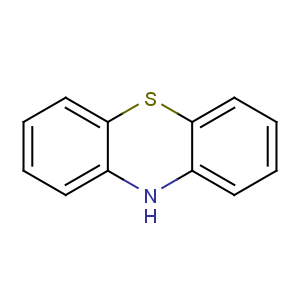Title: Phenothiazine
CAS Registry Number: 92-84-2
CAS Name: 10
H-Phenothiazine
Synonyms: thiodiphenylamine; dibenzothiazine
Trademarks: AFI-Tiazin; Antiverm; Fentiazin; Helmetina; Lethelmin; Nemazine; Orimon; Phénégic; Phenoverm; Phenovis; Phenoxur; Reconox; Souframine; Vermitin
Molecular Formula: C12H9NS
Molecular Weight: 199.27
Percent Composition: C 72.33%, H 4.55%, N 7.03%, S 16.09%
Literature References: Prepd by fusing diphenylamine with sulfur: Bernthsen,
Ber. 16, 2896 (1883);
Ann. 230, 73 (1885);
DE 25150 (1883),
Frdl. 1, 252. Improved yields with iodine as catalyst: Knoevenagel,
J. Prakt. Chem. [2]
89, 11 (1914); Mitchell, Webb,
US 2415363 (1947 to Koppers). Purification: Vierling,
US 2887482 (1959); Rigby,
US 3000887 (1961 to Shell Oil). Crystal structure: J. D. Bell
et al., Chem. Commun. 1968, 1656.
Properties: Yellow, rhombic leaflets or diamond-shaped plates from toluene or butanol, mp 185.1°. Sublimes at 130° at 1 mm. bp760 371°; bp40 290°. Freely sol in benzene; sol in ether, in hot acetic acid; slightly sol in alcohol and in mineral oils. Practically insol in petr ether, chloroform, water. Readily oxidized by sunlight or when in presence of a finely divided inert carrier, acquiring a greenish-brown tint. This can be prevented by the admixture of 0.3-1.0% methenamine.
Melting point: mp 185.1°
Boiling point: bp760 371°; bp40 290°
CAUTION: Potential symptoms of overexposure are itching, irritation and reddening skin; hepatitis, hemolytic anemia, abdominal cramps, tachycardia; kidney damage; skin sensitization and photophobia.
See NIOSH Pocket Guide to Chemical Hazards (DHHS/NIOSH 97-140, 1997) p 248.
Use: Insecticide; manuf pharmaceuticals.
Therap-Cat-Vet: Anthelmintic.

